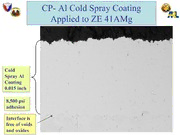
DTIC ADA599398: Cold Spray Technology for Repair of Magnesium Rotorcraft Components (Briefing Charts) PDF
Preview DTIC ADA599398: Cold Spray Technology for Repair of Magnesium Rotorcraft Components (Briefing Charts)
Cold Spray Technology for - Repair of Magnesium Rotorcraft Components EESSTTCCPP PPrrooppoossaall 0066--EE--PPPP33--003311 Team: ARL Bruce Sartwell - Naval Research Laboratory Yogi Kestler – NADEP Cherry Point Tim Eden – ARL-PSU Robert Guillemette SIK Report Documentation Page Form Approved OMB No. 0704-0188 Public reporting burden for the collection of information is estimated to average 1 hour per response, including the time for reviewing instructions, searching existing data sources, gathering and maintaining the data needed, and completing and reviewing the collection of information. Send comments regarding this burden estimate or any other aspect of this collection of information, including suggestions for reducing this burden, to Washington Headquarters Services, Directorate for Information Operations and Reports, 1215 Jefferson Davis Highway, Suite 1204, Arlington VA 22202-4302. Respondents should be aware that notwithstanding any other provision of law, no person shall be subject to a penalty for failing to comply with a collection of information if it does not display a currently valid OMB control number. 1. REPORT DATE 3. DATES COVERED JAN 2007 2. REPORT TYPE 00-00-2007 to 00-00-2007 4. TITLE AND SUBTITLE 5a. CONTRACT NUMBER Cold Spray Technology for Repair of Magnesium Rotorcraft 5b. GRANT NUMBER Components 5c. PROGRAM ELEMENT NUMBER 6. AUTHOR(S) 5d. PROJECT NUMBER 5e. TASK NUMBER 5f. WORK UNIT NUMBER 7. PERFORMING ORGANIZATION NAME(S) AND ADDRESS(ES) 8. PERFORMING ORGANIZATION Naval Research Laboratory,4555 Overlook Ave., SW REPORT NUMBER ,Washington,DC,20375 9. SPONSORING/MONITORING AGENCY NAME(S) AND ADDRESS(ES) 10. SPONSOR/MONITOR’S ACRONYM(S) 11. SPONSOR/MONITOR’S REPORT NUMBER(S) 12. DISTRIBUTION/AVAILABILITY STATEMENT Approved for public release; distribution unlimited 13. SUPPLEMENTARY NOTES 27th Replacement of Hard Chrome and Cadmium Plating Program Review Meeting, January 23-25, 2007, New Orleans, LA. Sponsored by SERDP/ESTCP. 14. ABSTRACT 15. SUBJECT TERMS 16. SECURITY CLASSIFICATION OF: 17. LIMITATION OF 18. NUMBER 19a. NAME OF ABSTRACT OF PAGES RESPONSIBLE PERSON a. REPORT b. ABSTRACT c. THIS PAGE Same as 43 unclassified unclassified unclassified Report (SAR) Standard Form 298 (Rev. 8-98) Prescribed by ANSI Std Z39-18 Cold Spray Technology for - Repair of Magnesium $$ Rotorcraft Components Program Objectives: • To reclaim ZE 41A magnesium alloy components on Army and Navy helicopters that have been removed from service due to severe corrosion and/or wear. • ARL will provide a repair/rebuild cold spray procedure for scrapped parts and assist in the transition and implementation of this technology, initially, at NADEP, Cherry Point, NC. Cold Spray Technology for Repair of Magnesium Rotorcraft Components - Meeting Objective: to lay the foundation for a JTP that can be executed by the ESTCP team such that at the completion of the program NADEP, Cherry Point has a fully functional cold spray system that is reclaiming magnesium rotorcraft components. •Overview of Cold Spray Technology •Leveraged Programs ( unprecedented head start) •Discuss ARL Capabilities and Advantages of Cold Spray •Present Test Results to Date •Coating Integrity and Microstructural Analysis •Adhesion, Hardness and Corrosion Tests •Coating Material Selection and Powder Development •Cold Spray Process Development and Hardware Modifications •Cold Spray Demonstration on ZE 41A Mg Housings Cold Spray Center at the US Army Research- Laboratory (ARL) Aberdeen Proving Ground, MD 21005-5069 ARL Cold Spray Research Team Phillip Leyman Process Engineer (410) 306-0818 Dr. Dennis Helfritch Process Engineer (410) 306-1928 Dr. Matthew Trexler Materials Engineer (410) 306-0808 Michael Lister Materials Engineer (410) 306-1592 Scott Grendahl Materials Engineer (410) 306-0819 Dr. William DeRosset Modeling/Simulation (410) 306-0816 Marc Pepi Mechanical Engineer (410) 306-0848 Victor Champagne Team Lead/Materials (410) 306-0822 ARL Leveraged Formal Programs •to develop aluminum cold spray coatings for aluminum, magnesium and/or steel substrates have been established with the following: 1. Defense Science & Technology Organization (DSTO) 2. Joint Strike Fighter (JSF) 3. National Center for Manufacturing Sciences (NCMS) 4. Lockheed Martin 5. Penn State Applied Research Laboratory 6. Lawrence Livermore National Labs (LLNL) 7. South Dakota School of Mines (SDSM) Overview of Cold Spray Technology - Cold Spray: a process by which particulates are deposited by means of ballistic impingement upon a suitable substrate at super sonic velocities to form a coating or a free-standing structure. GGaass CCoonnttrrooll MMoodduullee EElleeccttrriicc HHeeaatteerr Cold Spray System Configuration NN oorr 22 SSuubbssttrraattee HHee ggaass PPaarrttiiccllee SSttrreeaamm PPoowwddeerr FFeeeeddeerr SSuuppeerrssoonniicc NNoozzzzllee DDeeppoossiitt (cid:190)Main Gas Stagnation Pressure 100-500 psi (cid:190)Gas Temperature 0-1300ºF (cid:190)Main Gas Flow Rate 30-100 CFM (cid:190)Powder Feed Rate 10 to 30 pounds/hour (cid:190)Particle Velocity 300-1500 m/sec. (cid:190)Particle Size 1-100um diameter Cold Spray Advantages - Super Plastic Particle Agglomerate Mixing (SPAM) bond plastic deformation may disrupt thin oxide surface films to permit bonding similar to explosive welding Compressive residual stresses particles “peen” surface plasma and wire-arc thermal spray coatings tend to be in tension High density low porosity: < 0.5 % low oxide content <0.3% Thick coatings free-form fabrication Low Temperature Application thermally sensitive substrates low stresses due to CTE mismatch Cold Spray vs. Thermal Spray Cold Spray is performed at lower temperatures at high particle velocities Copper Particle Impact Site Copper Particle Impact Site Cross section of the impact site between a copper particle and a stainless steel substrate. From Dykhuizen et al, J. Thermal Spray Tech, Dec 1999.
